
|   |

|   |
The 20th Guru Kelucharan Mohapatra Award Festival - Lalitha Venkat e-mail: lalvenkat@yahoo.com Photos: Arabinda Mahapatra September 13, 2014 One would have expected the 20th edition of Guru Kelucharan Mohapatra Award Festival to be a grand affair but it started off on a rather low key without any fuss. The lobby of Rabindra Mandap was decorated with a couple of photo images of Kelubabu and a wall to wall montage of past recipients of the Guru Kelucharan Mohapatra Award. The stage was minimally decorated with a few potted plants/flowers. After a brief inaugural ceremony, the five day festival got off to a good start on September 5, 2014 with an involved performance of Odissi by Ramli Ibrahim, the director of Sutra Dance Theatre, Malaysia. Clad in a yellow costume with maroon border and a string of necklaces, he commenced with a Mangala Charan on the theme of Hari Hara, the powerful composite god of both Vishnu and Shiva reflected with Sabdaswara pata of Debaprasad style. In the Jayadeva ashtapadi Priye Charushile, the repentant Krishna, eventually anguished by his separation from his beloved Radha, pleads with her ardently. Choreographed by Guru Debaprasad Das, it brought out the abhinaya prowess of Ramli, a forte that he could explore further as his strength lies now in expressive numbers. Unfortunately, the flaw in stage design at Rabindra Mandap is such that when a performer sits and emotes, it cannot be seen by the audience beyond the first 4 rows. Ramli concluded with Ashta Shambo in Malava Kaushika, a choreography of Guru Debaprasad Das, describing the 8 fold forms of Lord Shiva, together with his attributes and mythic episodes connected with him. The many poses that required balance were executed admirably by Ramli in this vigorously charged item. Striking light direction by Jayadev added to the appeal of the presentation. The accompanists were Sukanta Kumar Kundu on vocal, Dhaneswar Swain on mardala, Abhiram Nanda on flute, Guru Gajendra Panda on manjira and Sapneswar Chakravorty on sitar. On opening the festival, Ramli says, “When Ratikant Mohapatra visited Kuala Lumpur to teach and perform at Temple of Fine Arts, he invited me to perform for the festival. As you know, although I am from Debaprasad Das school of Odissi, this does not stop me from admiring the legendary late Guru Kelucharan Mohapatra as an iconic figure of Odissi dance. The invitation to perform at this fest is a great honour for me.” 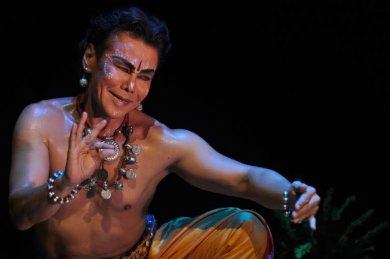 Ramli Ibrahim 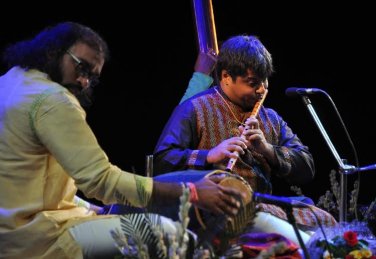 Sai Giridhar & Shashank On September 6, Bharatanatyam dancer Vaibhav Arekar from Mumbai wowed the audience with his excellent presentation. He dedicated his performance to his guru Thangamani Nagarajan who passed away recently. Clad in off-white costume with maroon border and minimal aharya, Vaibhav chose to present four pieces with different moods. The performance began with a kriti on Ardhanarishwara, a composition of Muthuswami Dikshitar in Kumudakriya. More than the iconographic representations of Shiva-Shakti, the choreography dealt with the concept of the dual masculine and feminine energies seen through beautifully essayed distinct movements. Red and green lighting in perfect symmetry highlighting the male and female in the ardhanariswara pose was a master touch. Vaibhav then presented one of his favourites –Subhashitas from Ratnakosha. These are two unusual shlokas choreographed by Dr. Kanak Rele that explore hasya rasa, not a very common happening in a Bharatanatyam concert. In one, the central figures are little Ganapati and Kartikeya, and in the other it is Lord Shiva. When the kids have a tiff, their mother Parvati mediates. Ganapati complains that Kartikeya tweaks his ears, holds his nose (trunk) to measure it. Kartikeya, who has 6 heads, complains that Ganapati makes fun of his 12 eyes. This humorous banter was charmingly portrayed delighting the rasikas. The Shiva story had the audience in splits even as Vaibhav made the announcements. Shiva is here a digambara (one with no clothes) immersed deep in meditation. His ganas stand guard around him when they suddenly espy Vishnu on his garuda dropping in for a visit. With a great deal of effort, they try various entertaining ploys to wake up Shiva so he can be suitably clad to greet his guest. Shiva quickly wraps a tiger skin around his waist and ties the snake from around his neck as a belt to keep his garment in place. A couple of taps on the snake’s head to keep it in control was a nice touch. The garuda and snake being natural enemies, the snake starts shivering in fear while the garuda assumes a predatory stance. When the snake breaks free and escapes leaving Shiva unclad, the sight embarrasses Vishnu who makes appropriate expressions, bringing down the house with laughter. Vaibhav’s theatre background helped him bring out the drama vividly with ease. The story can be funny but it needs that special something to bring out the comedy in dance. And Vaibhav definitely scored with his vivid and vivacious enactment. The humour connected with the audience who happily responded with thunderous applause. The mood for the next piece changed to somber. The story of Nandanar was based only on ragam-tanam of Todi. Not based on any poetry that is sung, it relies on the aspect of natya in dance and explores the possibilities of classical dance without dependency on words “Though at one point it is a work on the low caste saint and his angst at not being able to enter a temple and have the vision of his lord Shiva, on the other level this work goes beyond any particulars to represent the ones who live on the margins,” says Vaibhav. The silhouette of a (temple) door with the dancer in front of it was dramatic. Totally involved in the character, Vaibhav excelled as Nandanar coaxing, cajoling, throwing tantrums, pleading, rolling on the ground in frustration asking Nandi to move just a teeny bit so he could get a glimpse of Shiva. And the ecstasy when Nandi finally moves to oblige him was palpable. Indeed, a very touching portrayal. Vaibhav ended the concert with Ritumala in Ragamalika and Talamalika, on the four seasons Greeshma, Varsha, Shisheer and Vasanta, signifying that what ends shall begin again. It was an excerpt from his new production Trayanta. This item was ideal to witness Vaibhav’s prowess in energetic nritta and the depiction of various birds and animals was imaginatively executed. The accompanists were nattuvanar Kalishwaran Pillai, vocalist Shivprasad, mridangist Dakshinamurthy Pillai and violinist Satyavishal with excellent light design by Sushant Jadhav. The group earned a well-deserved standing ovation and loud cheers! “There are many who can be followers, but only a handful, who pave the path that is to be followed. And Kelubabu was one such genius. I have been in awe of him for all these years. Hence it’s an honour to perform in this festival that is dedicated to this artist par excellence. He was the brilliant sun and even if I could be just a tiny star billions of miles away, I will be so grateful,” said Vaibhav. 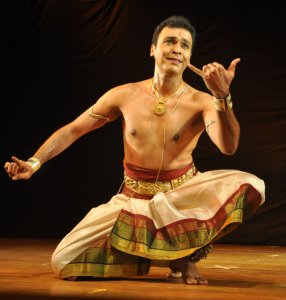 Vaibhav Arekar 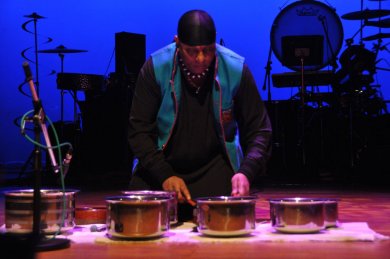 Sivamani The third evening of the fest started with Odissi exponent Daksha Mashruwala performing invocation Jagat janani to music by Manoj Desai and an emotion laden ashtapadi Yahi Madhava choreographed by Kelubabu to Pt Bhubaneswar Mishra’s music in raag Bhairavi. She used recorded music. In the second half, about 12 of her disciples presented ‘The Saggy Baggy Elephant.’ It is inspired by a children’s book published in 1947, written by Kathryn and Byron Jackson. It is a sweet story of an isolated and a lonely elephant Sooki, who is on his own little journey of self-discovery. On his way he interacts with a parrot who ridicules his appearance. A sad Sooki however continues his journey only to get more curious about himself as he comes across many creatures like the tiger, ducks, peacocks, crocodile and a hungry lion. The moral in the story is that one never realizes one’s potential and capability. This story was illustrated with a backdrop featuring lovely sketches of the flora and fauna of the particular scene in the jungle and vibrant choreography by Ratikant Mohapatra set to a catchy music composition by Agnimitra Behera. One saw parrot, eagle, deer, the ducks charmingly wag their short tails, the crocodile slithering around the stage, the tiger, dancing peacocks and playful elephants apart from the main elephant hero. When two choreographers work together on a production, there is a meaningful exchange of ideas. The book which originally belonged to Daksha’s husband soon became a favorite story of Daksha’s daughter in her childhood. It was she who suggested putting it in dance form to her mother, thus making it a sort of sentimental journey. While Daksha put the concept together and worked on it with her dancers for a few months, she invited Ratikant Mohapatra’s rhythmic inputs. “This subject had Ratikant interested in the choreographic aspects too and he joined us about 8 months after the project took shape. His ideas are so different and this story needed that special input. He added new movements and expanded the Odissi movement vocabulary. There are some very challenging inputs by Ratikant not commonly seen,” says Daksha, whose niece Amruta Shah came up with the multimedia aspect to support the production. There is also simple narration through voice over. This 20 minute production would definitely be a treat for young audiences. 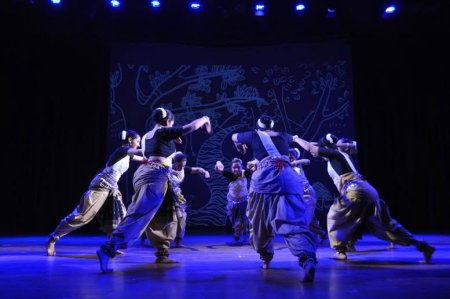 The Saggy Baggy Elephant  Daksha Mashruwala  Deepak Pandit The evening’s music recital was a violin concert by Deepak Pandit accompanied by Hira Pandit on tabla and Rajesh Srinivasan on mridangam. A melodious number in raag Charukesi in ek taal and madhyalay displayed a super understanding between violinist and tabla player. Next was raag Puryadhanashree in madhya, drut and atidrut moving on to Amritavarshini. Melody gave way to speedy display of restlessness in the ragamala featuring a combination of ragas like Tilang, Khamas, Desh, Hamsadhwani, Jhinjoti, Natbhairav etc. The solo percussion segments were appreciated by the audience. The final composition in Mishra Bhairavi had Rajesh Srinivasan on kanjira and the tempo fortunately slowed down after the frenzy of the previous number. Dynamic Kathak dancer Prashant Shah divides his time between New York and Ahmedabad. His Kathak recital on day four of the festival stood out for its elegance, aesthetics and classy costume designs. The first item was Mharo Pranam, whose original composition is a beautiful rendition of Meerabai’s bhajan sung by Kishori Amonkar (khyal in the Jaipur-Atrauli Gharana style). Vocalist Praher Vora’s soulful rendition accompanied by Prashant’s firm footwork and jangling of the ghunghroos in tandem with Joby Joy’s tabla beats was breathtaking. It was a stirring moment when Prashant finished the item as a pranam before the photo image of Kelubabu on the right corner of the stage. Based in teen taal (16 beats), the nritta or pure dance segment Aakar contrasts the beauty of stillness and speed, subtlety and strength. The rhythmic compositions included Uthan (small teasers), Toda and Tukda (compositions using tabla and dance syllables), Paran (compositions using rhythms of a pakhavaj drum), and lastly Baat (rhythmic footwork patterns). Aakar literally means a ‘shape’ and the dancer created various visual shapes through the Kathak technique. In this piece, Prashant highlighted the balance between speed and his command over the masculine graceful energy through jumps and chakkars. The authoritative footwork cracked like a whip on the floor. A quick change of costume and Prashant next presented a ghazal Hamara dil savere ka sunahra jaam ho jaye, Chiraghonki taraha ankhen jalen jab shaam ho jaye. Bashir Badr, the sovereign of modern ghazals, based them on themes like love, passion, beauty as well as social issues. It was an aesthetically charged performance to soulful singing by the vocalist. The original music was composed and sung by late Pandit Atul Desai. Prashant says, “It is always an honor to get associated with Atul bhai’s work through my performance. In all my formative years at Kadamb, it was his interactions, discussions and music recordings that helped me to learn the aesthetics of music in Kathak dance. Atul bhai was a vocalist, educator and an impeccable music composer for Kathak. He always said music should dance and I think of him whenever music is composed. I am fortunate to perform this beautiful ghazal composed by him.” Marked with clarity of footwork, Prashant concluded with Dhrut Laya with Jugalbandhi and the hall rang with “Wah, kya baat hai!” every time he finished a segment with an elegant flourish. About performing in the fest, Prashant starts with a quote by Guru Kelucharan Mohapatra: Dance has not only made my life purposeful, it has been my whole life... Whatever I am today is entirely due to the blessings of my guru. “This quote is not mere few lines for me. It has always added a great meaning to my life. Whenever I read this, it keeps me more connected with my life – the dance and also my roots – my guru. My guru Kumudini Lakhia has always given me liberty to fly high and use my wings to create new language of Kathak technique by exploring within the rich traditional vocabulary of Kathak. But at the same time, I firmly believe in sticking to my roots – my guru. It’s my long association, bonding, understanding and training with her, that makes me feel more confident in my ongoing journey of Kathak as a dancer, teacher and a choreographer. Being a male dancer, I always wanted to create a style of masculine grace with power. The aesthetics of grace, beauty in the dance form became as important as speed to me in my creative thought process. I don’t know whether I have been successful in achieving this dream in this ongoing journey of mine as a dancer / choreographer. But one thing I can definitely say is that this dream’s seed has been Guru Kelucharan-ji’s various videos that I have seen all my life. He has been one of the highly inspirational legendary figures to me in my life. I would call myself a bit unfortunate as I did not see any of his live performances but I am definitely fortunate to get his blessings by being able to present my Kathak at this prestigious award festival in his name.  Prashant Shah  Niladri Kumar The music component for the evening was a sitar concert by Niladri Kumar accompanied by Satyajit Talwalkar on the tabla. A bandish in raag Jhinjoti learnt directly from his paternal grandfather had even the softest note drop into the silence much to the delight of the music lovers but as the item progressed, the melody gave way to breakneck speed where the melodic element disappeared and only the loud blurred sounds of vigorous strumming remained.  Awardees On the last day of the festival, the 20th Guru Kelucharan Mohapatra Award was presented by Odisha Chief Minister Naveen Pattnaik to Niranjan Satapathy in the field of theatre, Guru Sudhakar Sahoo in the field of dance, Pt. Umesh Chandra Kar in the field of music and Prashant Nanda in the field of cinema for their outstanding contribution. Each award carries Rs.50,000 and a citation and it was indeed heartwarming to see such veterans being recognized and honored. 
Synthesis
The grand finale was the presentation by Srjan dancers. Every year, Guru Ratikant Mohapatra premieres a new production for the finale of the fest and has rasikas eagerly anticipating what theme he would come up with every year. The first item Synthesis was experimental and Kubjaa was in traditional style. According to choreographer Ratikant Mohapatra, “It is a combination of ideas into a complex whole. I’ve gone beyond the circular and semi-circular movements of Odissi and brought in new movements like leg lifts and stretches, movements from contemporary, ballet and folk forms. Music is also contemporary. I always use the basic discipline of Odissi. I use only Odissi costume and music and the main instruments like mardala with which tonal differences can be produced. I feel fusion can be done using the main instruments of Odissi.” Music is by Annada Prasanna Pattnaik, additional music by Satyabrata Katha, interludes and interlinking music by Tarakant Panda. Anything done with passion and conviction is shraddha. The lines are taken from Shraddha Sukta of Rig Veda. Says scholar Nityananda Mishra, “I’ve used only one line each. There are no sancharis, no repetitions. It’s like an abstract dance-sloka-dance. Veda is universal, without regional limitations and one can see how well Vedic hymns blend with dance.” Since a combination of unlikely ideas is brought together, the item is aptly named Synthesis. In the ten minutes, the very well trained dancers presented a beautifully synchronized set of movements in perfect circles and different line formations, their feet stamping on the floor in firm rhythms. The story of Kubjaa (Hunchback Woman) was in traditional Odissi. When penning the lyrics, Nityananda Mishra has totally followed the Bhagavatam. As not every lyric in Sanskrit is danceable, Mishra has used typical Odiya words in translation to get the meaning across to the audience. These words are not used generally when talking or writing. This piece is conceived as a conversation between Krishna and Kubjaa with narration from point of a third person. Choreographed by Ratikant, music is by Laxmikant Palit. Rupak Kumar Parida, Ira Mohanty and Kshiti Prakash provide the vocals. Srimad Bhagavatam says, “Na te bhavasyesha bhavasya kaaranam, vinaa vinodam bata tarkayaamahe.” Krishna is beyond ‘birth’ and only descends on this world to entertain himself through his numerous leelas, the story of Kubjaa being one. After entertaining gopis in Vrindavan, Krishna goes to Mathura with his elder brother Balarama on a royal invitation from Kansa. The beautiful maidens of Mathura eagerly await their handsome guest. The grand road to the palace has been decorated for the Dhanu Festival. Enjoying the scene of the picturesque Mathura, Krishna makes his way to the palace of Kansa. On the way he encounters a beautiful maiden with a hunchback. Krishna wishes to release Kubjaa of her handicap. One glimpse of Krishna from her tilted face and Kubjaa is mesmerized. She introduces herself as Tribakraa (body bent in 3 places), the maid engaged in the services of king Kansa to decorate his body with sandalwood paste. Krishna too wants to be decorated by her and she grants him his wishes. In return, Krishna puts his foot on Tribakraa’s feet, lifts her chin by his palm giving her an upward push. The hunch disappears and she turns into an upright, beautiful maiden. Besotted with Krishna, she begs him for a union. Krishna promises to meet her on the way back from the palace. Both the brothers participate in the festival, fight and kill a few demons. Tribakraa suffers from separation pangs till Krishna returns and fulfils her desire 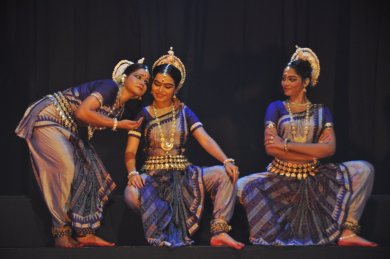

Kubjaa
The opening scene shows an artistically choreographed scene of a chariot
carrying the brothers, dancers on their haunches moving
quickly as the rolling wheels. The fight is shown as a silhouette and
the group comes in during the narrative passages, performing in perfect
sync with each other. Manosmita Panda as Kubjaa, Rajashree Praharaj as
Krishna and Aishwarya as Balarama performed their roles well. But the
last scene needs some editing as the ‘union’ goes on in different poses
against a stenciled pattern projected on the backdrop. Just a couple of
poses could perhaps be shown suggestively in silhouette for a mystic
effect and the production could end there on a dramatic note. The
beautiful costumes of the dancers in grey with purple border were
aesthetic but the lighting effects could be more subdued. The disco like
streaks of yellow lights towards the end could have been avoided.
Originally written by Mishra as a solo for another dancer including the
Kubjaa episode, the work seemed better suited for a group production and
Ratikant, who loves to do unusual characters, took it up. With a little
bit of modifications, the production is sure to be a big hit. Srinibas Ghatuari made his Odiya announcements in his usual charming inimitable fashion. The festival paid homage to Dr. Sarat Chandra Pujari who passed away a few months back. The team Srjan, as usual, did a great job of conducting the festival with finesse and the hospitality extended by them is a benchmark for all festivals to follow. More photos of the festival Photos: Lalitha Venkat Lalitha Venkat is the content editor of www.narthaki.com |